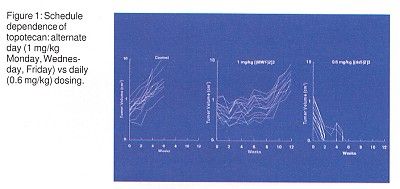Preclinical Studies Show Camptothecins Are Highly Schedule Dependent
MEMPHIS-‘‘Camptothecin activity is schedule dependent and is very S-phase-specific at concentrations we can achieve in vivo," Peter J. Houghton, PhD, said while summarizing the results of preclinical studies with camptohecins. "Protracted administration is optimal, and threshold concentrations are critical," he continued. Dr. Houghton is chairman of the Department of Molecular Pharmacology at St. Jude Children’s Research Hospital in Memphis.
MEMPHIS‘‘Camptothecin activity is schedule dependent and is very S-phase-specific at concentrations we can achieve in vivo," Peter J. Houghton, PhD, said while summarizing the results of preclinical studies with camptohecins. "Protracted administration is optimal, and threshold concentrations are critical," he continued. Dr. Houghton is chairman of the Department of Molecular Pharmacology at St. Jude Children’s Research Hospital in Memphis.
Dr. Houghton illustrated the schedule dependence of topotecan (Hycamtin) in a comparison of daily vs alternate-day dosing (Figure 1). He said that 30% to 40% of tumors are "dramatically dependent on dose scheduling" and that cellular determinants of response may be less important than these pharmacokinetics in many situations.

Camptothecin analogs are being evaluated for possible therapeutic efficacy in xenograft models in which human tumors are grafted into immune-deficient mice. Studies with irinotecan (Camptosar) showed that 5 days of treatment had much less effect than 10 days of treatment at half the dose. "Mice are poor models for toxicity but can be used to evaluate antitumor effects," Dr. Houghton said. "This is done by relating clinically achievable systemic exposure levels to those that produce antitumor effects in the xenograft model.
Clinical Studies Designed
Based on these data, clinical studies were designed to test topotecan in a phase II study of 22 children with stage IV neuroblastoma. Dr. Houghton said that the schedule of administration was derived directly from the xenograft model results (daily x 5 x 2). Treatment produced partial responses in 13 of 22 children (59%) and stable disease in 9 patients.
Irinotecan has similarly progressed to a phase I study in 23 children with refractory or relapsed solid tumors, with the schedule of administration derived again from the xenograft model (daily x 5 x 2). Dr. Houghton said that diarrhea was the dose-limiting toxicity and that hematologic toxicity was minimal. The cumulative area under the curve of SN-38 (the active metabolite of irinotecan) was two- to fourfold higher than observed in adult studies. ‘‘There were 5 partial responses and 17 patients with disease improvement that did not qualify as a partial response," Dr. Houghton said. The maximum tolerated dose was 20 mg/m2/dose, and cumulative dose per cycle was 200 mg/m2.
Based on these studies, Dr. Houghton said that preclinical studies of combination therapy are underway with topotecan plus vincristine, irinotecan plus the methylating agent temozolamide (Temodar), and irinotecan plus the EGF receptor antagonist ZD1839 (Iressa).
"Temozolamide in combination with irinotecan is appealing because there are nonoverlapping organ toxicities and a potential mechanism for interaction," Dr. Houghton said. The synergy is only partly dependent on O6-methylguanine-DNA methyltransferase (MGMT) and efficacy may vary according to tumor MGMT activity levels.
Schedule Dependent Synergy
"In preclinical trials, we have seen synergy in tumors with high MGMT levels and in tumors deficient in mismatch repair mechanisms," Dr. Houghton said. "Temozolamide combined with irinotecan produces greater than additive antitumor activity against eight of the nine xenograft lines tested. Synergy is schedule dependent. Dosing of temozolamide plus irinotecan should be sequential: temozolamide should be given first, then irinotecan."
In summary, Dr. Houghton said that camptothecins are very active in preclinical models, but that activity is highly schedule dependent. "Irinotecan and topotecan are highly active against childhood solid tumors, and systemic exposures and schedules consistent with activity in model systems yield a high response rate in children," he said.